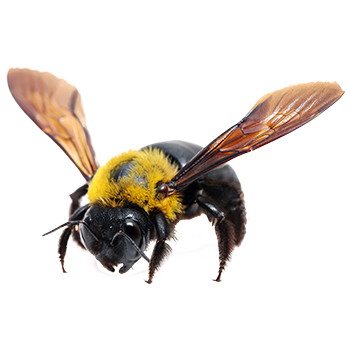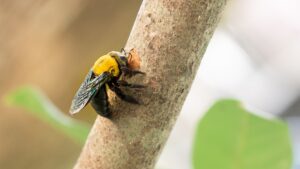Carpenter Bee Treatment

Protecting your property in New Jersey, Pennsylvania, Maryland and Delaware from pests is an important part of home and business ownership. Some types of pests are a threat to the people inside your building while others are a threat to the structure of your property. Wood-destroying organisms are among the most destructive types of pests that building owners face. Carpenter bees are a type of wood-destroying pest that can leave the wood around your home or business with unsightly damage. To protect your home or business from carpenter bees, you need to learn about the behavior of this pest, take steps for prevention, and find effective carpenter bee treatment options should an infestation occur.
What are Carpenter Bees?
Carpenter bees are a large species of bees that can be found throughout New Jersey, Pennsylvania, Maryland, and Delaware. This big black bee looks similar to bumblebees but can be accurately identified when you understand the differences between the two. The female can sting humans but will only do so if provoked. The male carpenter bee does not have a stinger and does not pose a threat. Female carpenter bees bore holes into wood to build their nests and lay eggs. This creates round holes in the wood that can be found in many different areas around your home or business including siding, fences, trees, lawn furniture, and swing sets.
How Do I Identify Carpenter Bees?
Carpenter bees are easy to confuse with bumblebees because they have several physical similarities. The size, shape, and coloring of these two types of bees are similar. One noticeable physical difference between the two can be found on the abdomen. Bumblebees have a fuzzy abdomen while carpenter bees have a shiny black abdomen. You can also distinguish carpenter bees from other types of bees by their behavior. Bumblebees live in colonies with many others, but carpenter bees are solitary and only share their nest with a mate and eggs. The females spend their time excavating wood for their nests, while the males play the role of protector against threats. The behavior of male carpenter bees can seem aggressive when they encounter a threat, but they do not have a stinger and are not a physical threat.
How Did I Get Carpenter Bees?
Carpenter bees are a common sight in eastern states such as Maryland, New Jersey, Delaware, and Pennsylvania. If you have wood on or around your home or business, you are at risk for developing a carpenter bee problem. These pests bore into softwoods like pine and cedar to build their nests and lay eggs.

What Are the Effects of Carpenter Bees in and Around My Home or Business?
Carpenter bees can cause unsightly damage to your structure. Female carpenter bees bore holes into wood. The holes they create are large enough for them to enter and lay their eggs. Since these pests range in size from ¾ of an inch to 1 inch, the holes are large enough to be easily noticed. This can cause significant visible damage to your home or business. If you have unexplained holes in the wood around your house and notice fine sawdust nearby, it is a possible indication that you have a carpenter bee infestation. Look for these holes in wooden areas around your house or business such as your deck, swing set, eaves, siding, patio furniture, or any wood surface.
“Carpenter bees create conditions that attract woodpeckers who feed on bee larvae within the wood,” says Craig S. ACE, PHE, Viking Pest’s Service Director. “If you have an issue with woodpeckers pecking on your house or shed, there’s a good chance they’re trying to get carpenters, silverfish or other insects.”
How Long Do Carpenter Bees Live?
In New Jersey, Pennsylvania, Maryland, and Delaware, carpenter bees can show up at your home or business in the spring and stay active throughout the summer. Female carpenter bees lay eggs in their nests during the warm months. As the cool weather approaches, they winter in the nests they created in the wood.
Without carpenter bee extermination, a new generation will emerge and repeat the cycle. Once eggs develop into adults, they leave the nest and go out on their own to bore more holes and lay more eggs.
How Do I Prevent Carpenter Bees?
 A professional carpenter bee treatment can help protect your home or business from the damage these pests create.
A professional carpenter bee treatment can help protect your home or business from the damage these pests create.
A big part of effective carpenter bee prevention is learning about their behavior and preferences. Carpenter bees need nectar to survive. There is no way for you to eliminate the availability of nectar around your property, so you must focus on other aspects of their behavior, such as where they are most active and what types of wood they prefer.
Common areas around your home or business where carpenter bees tunnel include eaves, wood shingles, window and door trim, fascia boards, porches, decks, swing sets, wood railings, and fence posts. You can keep an eye out for carpenter bee activity around these areas once spring arrives by doing regular inspections. Discovering the presence of these pests around your property will allow you to act before they have the opportunity to cause widespread damage.
Carpenter bees prefer to build their nests in unpainted softwoods such as redwood, spruce, pine, cedar, cypress, and fir. Painting over areas of exposed wood can help you in your carpenter bee prevention efforts by making the wood less attractive to the female carpenter bee. Painting the wood on your building will provide an extra layer of protection against this destructive pest, but don’t fill in or paint over carpenter bee holes without having them treated professionally.
Successful carpenter bee prevention in Maryland, Pennsylvania, New Jersey, and Delaware often requires the help of a professional carpenter bee exterminator. Before the spring arrives, you can bring in a pro to inspect your property for signs of previous carpenter bee activity. If nests are discovered, carpenter bee treatment can prevent the reemergence of these insects in the spring. When the weather warms up, a carpenter bee control professional can spot signs of activity and eliminate the carpenter bees before they do significant damage.














